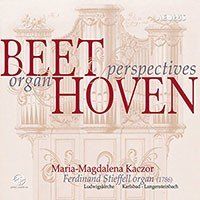« Beethoven ? But did he ever compose anything for the organ? » We do not know the exact answer to this question. Yet the theme of Beethoven’s relationship to the “King of Instruments” has time and again occupied, indeed fascinated musicologists, but above all organists. Why is this? Is it the hardly conceivable idea that the composer only wrote very little for the organ and above all – compared to his work overall – little of note? To supply proof that Beethoven bequeathed us compositions that – if indeed not expressly composed for organ – nonetheless may outstandingly be performed on the instrument of his youthful years for which he like many young people felt considerable fascination: such is the aim of the present recording...
In other words: several of the works recorded can surely convey a stimulating impression of the type of music the composer may have played on the organ and perhaps even would have composed if he had remain involved with the instrument of his youthful period beyond the year 1792. Hence it is intentionally that we decided on “organ perspectives” as a title for this recording and not something like “organ works.”.
After having accomplished her piano studies at the Paderewski Academy in Poznań (PL) the young polish performer of this album, Maria-Magdalena Kaczor, has studied organ in France and Germany between 2005 and 2012, what predestines her for this recording project.
The organ we've chosen, built by Ferdinand Stieffel in 1786 for the rococo chapel of the Karlsruhe Castle, is since 1871 located in the Ludwigs(!) Church (St.Louis) of Karlsbad-Langensteinbach (near Karlsruhe). Not only is this an instrument that was also originally made for a Castle Chapel, but it was created in the same period of time as the organ at which Beethoven served as 2nd court organist. Its specification even reveals several analogies to the organ Beethoven used to play in Bonn, making it virtually self-evident as a convincing solution. The Langensteinbach organ may be considered the most significant tonal monument to late 18th-century organ building in the Baden region. Indeed, it has in the meantime been affectionately dubbed the “Pearl of Baden.” It's tonal colors have been thoroughly recorded for this hybrid Super Audio CD in stereo and multichannel surround. On this purpose Aeolus has used two independent microphone setups thus making the new recording an absolute MUST for the lovers of audiophile organ recordings.
The 48 pages full color booklet evokes aspects of Beethoven's relation with the „King of the instruments“, informs in detail about the history of the Ferdinand Stieffel organ and Mrs. Maria-Magdalena Kaczor's biography. It also contains of course detailed comments on the recorded works. Numerous color pictures and some historic photographs enrich this extensive documentation.



